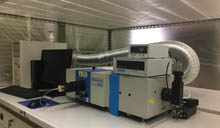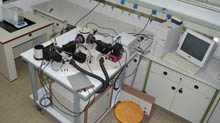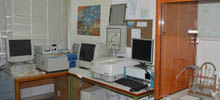
Il Laboratorio di Fotochimica Supramolecolare svolge attività di ricerca, anche in collaborazione con numerose università italiane o straniere, su tematiche centrate sulla fotochimica, la chimica supramolecolare, la conversione chimica di energia solare, lo sviluppo di sensori luminescenti per varie applicazioni, in stretta connessione con il Laboratorio di Spettroscopia Ultraveloce dello stesso Dipartimento. Il Laboratorio di Fotochimica Supramolecolare è stato ed è capofila di numerose iniziative di ricerca, inclusa la fondazione del Centro Interuniversitario di Ricerca per la Fotosintesi Artificiale, di cui fanno parte Dipartimenti di Chimica delle Università di Messina, Bologna e Ferrara. E' inoltre parte della European Photochemistry Association (EPA). Collabora attivamente ai progetti di ricerca a cui il Dipartimento aderisce. L'attività di ricerca sperimentale include progettazione e sintesi di nuovi cromofori, di dendrimeri e di specie supramolecolari e studio delle proprietà fotochimiche, fotofisiche ed elettrochimiche di tali nuovi sistemi. Alcuni dettagli sulla attività di ricerca del Laboratorio sono di seguito riportati. Svolge inoltre attività didattica relativa alla preparazione di tesi di laurea e di dottorato in Chimica.


Supramolecular Photochemistry Laboratory – some information on research activity
The research themes of the laboratory activities are inserted within the general framework of Supramolecular Photochemistry. Actually, an important driving force of photochemistry is currently the study of multicomponent (supramolecular) systems. One of the aims leading such studies is the extension of the concept of device (or machine) to the molecular level. A molecular device is an assembly of molecular components (i.e., a supramolecular structure) designed to achieve a specific function. Each molecular component performs one or more single acts, while the entire device performs one or more complex functions, characteristic of the assembly. Molecular devices, like macroscopic ones, need energy to operate. Light is the most convenient form of energy to make molecular devices work.
We are interested in designing and constructing light-active supramolecular systems, i.e., structurally-organized and functionally-integrated systems capable to perform complex functions and powered by light. Since light is made of photons, and photons are at the same time energy quanta and information bits, light-active supramolecular systems can use light in two different ways:
(i) as an energy supply to perform energy-expensive functions (i.e., directional energy transfer, charge separation, conformational changes);
(ii) as an input signal to process, store, and retrieve information.
Final aims of point (i) involve artificial photosynthesis, that is conversion of light energy into chemical energy. Point (ii) includes design of luminescent sensors, light-activated molecular logics, and new dyes for luminescence imaging and DNA probes.
Main topics under study at the moment are:
- Light-harvesting antenna systems
- Linearly-arranged multicomponent systems for photoinduced charge separation
- Integration of antenna systems, charge separation and multielectron transfer catalysts
- Photoinduced water splitting
- Design and study of new luminophores and redox-active systems
- Cell localization and pathway of internalization of suitably-functionalized dyes

Alcune Collaborazioni scientifiche attive
Università di Ferrara, Dipartimento di Scienze Chimiche e Farmaceutiche
Università di Bologna, Dipartimento di Chimica "G. Ciamician"
University of Montreal, Department of Chemistry
Université de Strasbourg, Institut de Science et d'Ingénierie Supramoléculaires
Université Diderot Paris, Department of Chemie
University of Newcastle, Department of Chemistry
University of Texas at Arlington, Department of Chemistry and Biochemistry
Ecole Normale Superior de Chemie, Paris-Tech, Department of Chemistry
University of California at Santa Barbara, Department of Chemistry and Biochemistry
Uppsala University, Department of Photochemistry
STRUMENTAZIONE ANNESSA
-Strumentazione di base per sintesi chimica.
-Spettrofotometro UV-Vis (range spettrale 200-800 nm, alta risoluzione)
-Spettrofotometro UV-Vis-NIR (range spettrale 200 – 1800 nm)
-Spettrofluorimetro Compact Steady-State Horiba FluoroMax (spettroscopia di eccitazione e di emissione)
-Spettrometro "Single-Photon-Counting" Edinburgh risolto nel tempo, per determinazione di tempi di vita di stati luminescenti, range spettrale 380-900 nm, range temporale 200 ps – 5 ms.
-Jobin-Yvon Spex Fluorolog modulare per spettroscopia di emissione, risoluzione 100 ps.
-Potenziostato/galvanostato per elettrochimica e spettroelettrochimica
- Home-made systems per spettroelettrochimica e per fotoeccitazione in fase stazionaria.
Responsabile:
Prof. Sebastiano Campagna
campagna@unime.it
090 6765709
Docenti
Prof. Fausto Puntoriero
fpuntoriero@unime.it
0906765727
Prof.ssa Scolastica Serroni
sserroni@unime.it
0906765725
Prof. Francesco Nastasi
fnastasi@unime.it
0906765726


